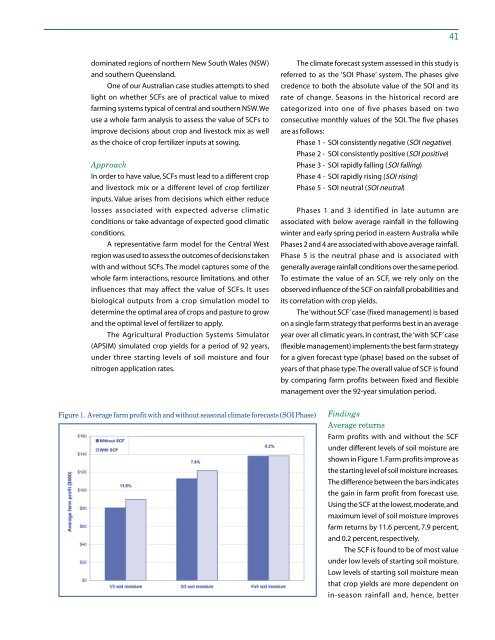Read More - Philippine Institute for Development Studies
Read More - Philippine Institute for Development Studies
Read More - Philippine Institute for Development Studies
Create successful ePaper yourself
Turn your PDF publications into a flip-book with our unique Google optimized e-Paper software.
41<br />
dominated regions of northern New South Wales (NSW)<br />
and southern Queensland.<br />
One of our Australian case studies attempts to shed<br />
light on whether SCFs are of practical value to mixed<br />
farming systems typical of central and southern NSW. We<br />
use a whole farm analysis to assess the value of SCFs to<br />
improve decisions about crop and livestock mix as well<br />
as the choice of crop fertilizer inputs at sowing.<br />
Approach<br />
In order to have value, SCFs must lead to a different crop<br />
and livestock mix or a different level of crop fertilizer<br />
inputs. Value arises from decisions which either reduce<br />
losses associated with expected adverse climatic<br />
conditions or take advantage of expected good climatic<br />
conditions.<br />
A representative farm model <strong>for</strong> the Central West<br />
region was used to assess the outcomes of decisions taken<br />
with and without SCFs. The model captures some of the<br />
whole farm interactions, resource limitations, and other<br />
influences that may affect the value of SCFs. It uses<br />
biological outputs from a crop simulation model to<br />
determine the optimal area of crops and pasture to grow<br />
and the optimal level of fertilizer to apply.<br />
The Agricultural Production Systems Simulator<br />
(APSIM) simulated crop yields <strong>for</strong> a period of 92 years,<br />
under three starting levels of soil moisture and four<br />
nitrogen application rates.<br />
The climate <strong>for</strong>ecast system assessed in this study is<br />
referred to as the ‘SOI Phase’ system. The phases give<br />
credence to both the absolute value of the SOI and its<br />
rate of change. Seasons in the historical record are<br />
categorized into one of five phases based on two<br />
consecutive monthly values of the SOI. The five phases<br />
are as follows:<br />
Phase 1 - SOI consistently negative (SOI negative)<br />
Phase 2 - SOI consistently positive (SOI positive)<br />
Phase 3 - SOI rapidly falling (SOI falling)<br />
Phase 4 - SOI rapidly rising (SOI rising)<br />
Phase 5 - SOI neutral (SOI neutral)<br />
Phases 1 and 3 identified in late autumn are<br />
associated with below average rainfall in the following<br />
winter and early spring period in eastern Australia while<br />
Phases 2 and 4 are associated with above average rainfall.<br />
Phase 5 is the neutral phase and is associated with<br />
generally average rainfall conditions over the same period.<br />
To estimate the value of an SCF, we rely only on the<br />
observed influence of the SCF on rainfall probabilities and<br />
its correlation with crop yields.<br />
The ‘without SCF’ case (fixed management) is based<br />
on a single farm strategy that per<strong>for</strong>ms best in an average<br />
year over all climatic years. In contrast, the ‘with SCF’ case<br />
(flexible management) implements the best farm strategy<br />
<strong>for</strong> a given <strong>for</strong>ecast type (phase) based on the subset of<br />
years of that phase type. The overall value of SCF is found<br />
by comparing farm profits between fixed and flexible<br />
management over the 92-year simulation period.<br />
Figure 1. Average farm profit with and without seasonal climate <strong>for</strong>ecasts (SOI Phase)<br />
Findings<br />
Average returns<br />
Farm profits with and without the SCF<br />
under different levels of soil moisture are<br />
shown in Figure 1. Farm profits improve as<br />
the starting level of soil moisture increases.<br />
The difference between the bars indicates<br />
the gain in farm profit from <strong>for</strong>ecast use.<br />
Using the SCF at the lowest, moderate, and<br />
maximum level of soil moisture improves<br />
farm returns by 11.6 percent, 7.9 percent,<br />
and 0.2 percent, respectively.<br />
The SCF is found to be of most value<br />
under low levels of starting soil moisture.<br />
Low levels of starting soil moisture mean<br />
that crop yields are more dependent on<br />
in-season rainfall and, hence, better










